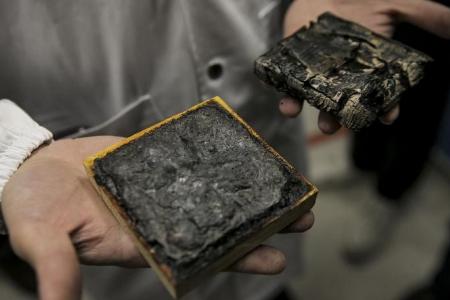NTU researchers develop transparent fire-resistant wood coating
A coating developed by researchers at Nanyang Technological University (NTU) can prevent wood from catching fire.
At NTU on Thursday (Aug 18), a researcher showed how it works.
Two panels of spruce wood were placed side by side in a testing chamber, the first showing its raw wood grain and the other with a slight sheen noticeable only when light reflects off it.
A burner that can heat substances to more than 800 deg C is applied to the two panels.
One crackled and blackened, as expected, and the other started foaming up, with its surface expanding to form a layer of insulation, protecting the wood underneath.
When the burner was switched off, the researcher scraped off the residue on the coated piece of wood to reveal that it was unscathed by the extreme heat.
Just a thickness of about 75 microns - the thickness of a sheet of paper - of the coating is needed to protect the surface of wood from fire. The wood needs to be cured overnight.
When heated to 300 deg C, the resin coating expands by up to 100 times in thickness, and it is this expansion that insulates and protects the wood from heat, according to Associate Professor Aravind Dasari from the NTU School of Materials Science and Engineering.
"Most timber or wooden panels only have a transparent coat that protects them from moisture, weather corrosion, termites or pests, and are not designed to withstand high heat," he said.
"Thus, timber can still burn very quickly, especially if it is unprotected."
Prof Aravind added that current methods of making timber and other wood surfaces more fire-resistant typically obscure the natural appearance of the wood.
These other methods, such as fire-retardant panels or paint, are costly and can release toxic gases when burnt.
The NTU coating's potential to stop fire damage would allow for more buildings to use timber as a structural element, a crucial step in the fight against climate change, said Mr Kevin Hill, managing director of building design firm Venturer Timberwork.
"People might ask, 'What has fireproofing got to do with climate change?' This has to do with the uptake of timber as a building solution.
"By bolstering the inherent properties of timber, we can increase the application of wood, which is not just a sustainable material but also carbon-negative since if demand rises, more trees will have to be planted," said Mr Hill.
The innovation comes on the back of a spate of fires this month. In the most recent case, a fire in a Jurong East HDB flat on Tuesday morning claimed a man's life.
On Aug 12, around 50 residents were evacuated from their homes when a Toa Payoh flat caught fire, and in May, a fire in a Bedok North flat killed three people, including a three-year-old child.
A director at local woodworking studio Roger and Sons, Mr Morgan Yeo, 34, said he had not received any requests from customers for fire-resistant coatings to be applied to the products they ordered.
"Furniture normally does not have to be made fire-resistant. It is not going to catch fire easily if you drop a candle or a burning piece of paper. Of course, if the fire is big enough, then anything will burn," he said.
"Plywood and chipboard, which is found in cheaper furniture, tends to be more flammable than hard woods such as teak or mahogany."
Get The New Paper on your phone with the free TNP app. Download from the Apple App Store or Google Play Store now



